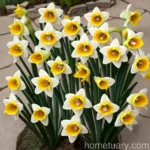The Fascinating World of Trumpet Daffodil (Narcissus ‘Brer Fox’): A Comprehensive Guide
Plants are an integral part of our lives, providing us with beauty, oxygen, and food. One particularly captivating plant is the trumpet daffodil (Narcissus ‘Brer Fox’). Known for its vibrant yellow trumpet-shaped blooms, this daffodil variety has enchanted gardeners and nature enthusiasts for centuries. In this comprehensive guide, we will delve into the culture, uses, care tips, and interesting facts about the trumpet daffodil. Whether you’re a seasoned botanist or a novice gardener, there’s always something new to learn about this captivating plant.
What is the Trumpet Daffodil (Narcissus ‘Brer Fox’)?
The trumpet daffodil, scientifically known as Narcissus ‘Brer Fox’, is a perennial plant belonging to the Amaryllidaceae family. It is a hybrid cultivar that boasts striking trumpet-shaped golden-yellow blooms, making it a beloved choice for spring gardens. The ‘Brer Fox’ variety is revered for its vigorous growth habit, early bloom time, and delightful fragrance.
This daffodil variety typically reaches a height of 14-16 inches (35-40 cm) and thrives in USDA hardiness zones 3-8. Its long, narrow leaves form an attractive backdrop for the resplendent flowers, creating a visually stunning display in gardens and landscapes.
Key Takeaways – Trumpet Daffodil (Narcissus ‘Brer Fox’)
Culture
- The trumpet daffodil is a perennial bulbous plant known for its vibrant golden-yellow, trumpet-shaped flowers.
- This daffodil variety is a hybrid cultivar, commonly grown for its early spring blooms and pleasant fragrance.
- ‘Brer Fox’ daffodils are well-suited for naturalizing, borders, and mixed perennial beds, adding cheerful color to the landscape.
Uses
- As a popular ornamental plant, the trumpet daffodil is extensively used in gardens, parks, and floral arrangements to infuse spaces with its bright, sunny hues.
- These daffodils are well-received as cut flowers, adding a touch of elegance to floral displays and arrangements.
Now that we have a brief overview of the trumpet daffodil, let’s explore the essential care requirements for cultivating and nurturing this charming plant.
Care Tips and Requirements
Successful cultivation of trumpet daffodils involves providing the optimal conditions for their growth and bloom. From water and sunlight to soil and fertilizer, each aspect plays a crucial role in ensuring the health and vitality of these plants.
Water
- Watering Frequency: Daffodils, including the ‘Brer Fox’ variety, prefer moderately moist soil during their growing season. Water them regularly, especially during the active growth phase in spring, and reduce watering after the foliage starts to yellow and die back.
- Drainage: Adequate drainage is essential to prevent waterlogged soil, which can lead to root rot. Plant the bulbs in well-draining soil and avoid overwatering, particularly during the dormant period.
Sunlight
- Sun Exposure: Trumpet daffodils thrive in full to partial sunlight. Plant them in a location that receives at least 6-8 hours of sunlight per day to promote robust growth and prolific flowering.
- Shade Tolerance: While they prefer sunlight, these daffodils can tolerate light shade, making them versatile for various garden settings.
Fertilizer
- Feeding Schedule: Apply a balanced, slow-release fertilizer or a bulb-specific fertilizer in early spring when the shoots emerge. Avoid excessive nitrogen, as it can lead to lush foliage at the expense of flower production.
- Bulb Health: After blooming, continue to fertilize the plants to nourish the bulbs and support their future growth and flowering.
Soil
- Soil Type: Trumpet daffodils thrive in well-draining, loamy soil with a slightly acidic to neutral pH (6.0-7.0). Amending heavy clay soil with organic matter can improve drainage and create a suitable growing environment for the bulbs.
Pruning
- Deadheading: Remove spent flowers to prevent seed formation, allowing the plants to channel their energy into bulb development. Deadheading also maintains the visual appeal of the planting area by preventing the formation of seed pods.
Propagation
- Division: Every 4-5 years, lift and divide overcrowded clumps of daffodils after the foliage has yellowed and withered. Replant the healthy bulbs in well-prepared soil to rejuvenate the planting area and promote vigorous growth.
Container Planting
- Container Selection: Choose a deep container with drainage holes to accommodate the daffodil bulbs’ root system and facilitate proper drainage.
- Soil Quality: Use a well-draining potting mix formulated for bulbs when planting trumpet daffodils in containers. Ensure that the soil is moisture-retentive but not waterlogged.
Now that we understand the care requirements for cultivating trumpet daffodils, it is important to recognize the plant’s popularity and common diseases that may affect its growth.
Popularity and Common Diseases
Popularity
- The ‘Brer Fox’ variety of trumpet daffodil is a sought-after choice for gardeners and landscapers, thanks to its elegant blooms and ease of cultivation.
- Its cheerful yellow flowers and delightful fragrance make it a desirable addition to spring gardens, borders, and naturalized landscapes.
Common Diseases
- Basal Rot: This fungal disease can affect daffodils, causing rotting at the base of the bulb and leading to stunted growth or failure to bloom. Proper soil drainage and avoiding overwatering can help prevent basal rot.
- Narcissus Bulb Fly: The larvae of the narcissus bulb fly feed on daffodil bulbs, potentially causing extensive damage. Monitoring the bulbs and applying appropriate control measures can help manage this pest.
Now, let’s explore some interesting facts about the trumpet daffodil and gain insights from seasoned botanists.
Botanist’s Tips
As a seasoned botanist, I have had the privilege of studying and cultivating the trumpet daffodil (Narcissus ‘Brer Fox’) over many years. Here are some valuable tips based on my experience:
- Naturalizing: When planting trumpet daffodils, consider naturalizing them in grassy areas or beneath deciduous trees to create a picturesque spring landscape.
- Companion Planting: Pair trumpet daffodils with complementary spring-blooming plants like tulips, hyacinths, and grape hyacinths to create visually stunning and harmonious garden displays.
- Bulb Storage: After the foliage has withered, allow the bulbs to remain in the ground to replenish their energy for the next blooming season. If necessary, lift and store the bulbs in a cool, dry place until the following planting season.
Now that we’ve covered the care tips, popularity, and insights from botanists, it’s time to explore some fun facts about the trumpet daffodil.
Fun Facts
- The trumpet daffodil (Narcissus ‘Brer Fox’) is named after the character “Brer Fox” from the Uncle Remus stories, known for his cunning and clever nature.
- Daffodils, including the trumpet variety, are associated with the birth flower for the month of March and symbolize rebirth, new beginnings, and hope.
- The name “Narcissus” is derived from Greek mythology, where Narcissus was a beautiful youth who fell in love with his own reflection. This mythological connection adds an intriguing layer to the plant’s identity.
With its fascinating history, cultural significance, and captivating blooms, the trumpet daffodil remains a beloved addition to gardens and landscapes around the world. If you’re eager to learn more about this enchanting plant and expand your knowledge, here are some helpful external resources to dive deeper into the world of trumpet daffodils.
Links to External Resources
- American Daffodil Society
- Royal Horticultural Society – Daffodils
- University of Vermont Extension – Daffodils
- National Gardening Association – Narcissus
- The Daffodil Society
In conclusion, the trumpet daffodil (Narcissus ‘Brer Fox’) stands as a timeless symbol of beauty, resilience, and the vibrant spirit of spring. By understanding its cultural significance, exploring its care requirements, and immersing ourselves in its captivating allure, we deepen our appreciation for this remarkable plant. Whether you’re an avid gardener, a nature enthusiast, or a curious soul with a passion for botany, the world of trumpet daffodils offers endless opportunities for learning, discovery, and inspiration.















